The Significance of Garnet: January 15 Birthstone
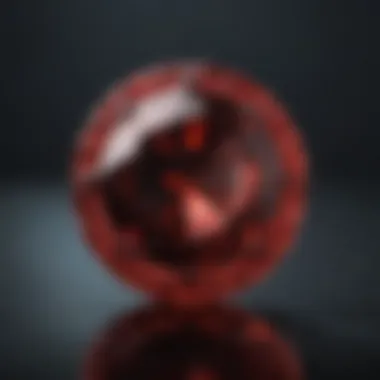
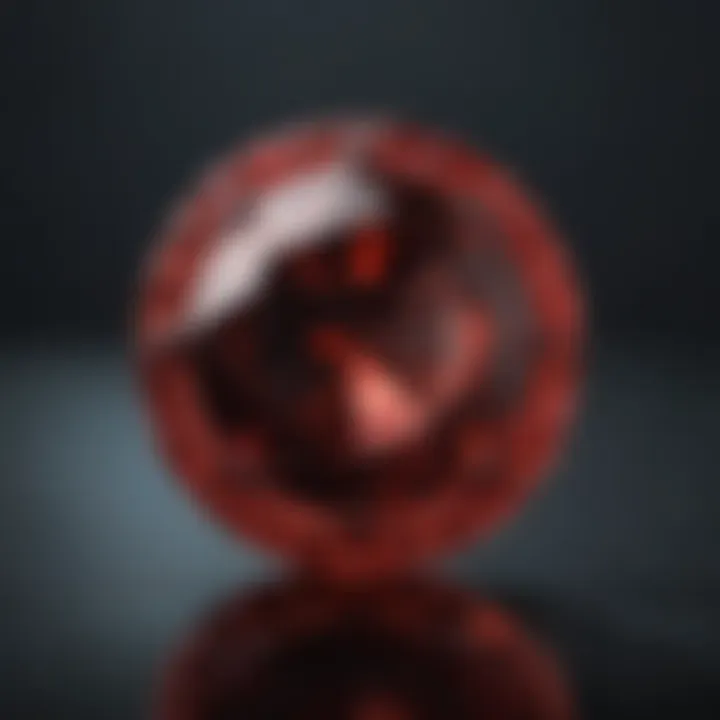
Intro
Garnet is not just a gemstone; it carries a wealth of history, spirituality, and artistic flair. For those born on January 15, this vibrant stone symbolizes much more than just another month on a calendar. It represents tenacity, passion, and a connection to the past. With deep crimson hues and a fascinating array of properties, garnet captures the hearts of gem enthusiasts and jewelers alike. This journey explores every facet of this captivating stone, from its essential characteristics to its cultural impacts throughout history.
Gemstone Overview
Definition and Characteristics
Garnet, a mineral group that encompasses a variety of silicate minerals, is renowned for its diverse color spectrum. Though most commonly associated with red, garnet can manifest in shades varying from green to yellow, and even in rare colorless forms. The unique chemical composition of garnets allows for over a dozen species, each with distinct attributes.
One of the most intriguing aspects of garnet is its crystal structure. Typically, garnets develop as dodecahedrons, a twelve-faced shape that gives them a striking appearance. Their hardness falls between 6.5 and 7.5 on the Mohs scale, providing durability that's ideal for various jewelry applications. Additionally, garnets are known for their exceptional brilliance and refractive index, making them delightful to behold in a well-cut setting.
Classification of Gemstones
Understanding the classification of gemstones is vital for any collector or enthusiast. Gemstones can be broadly categorized into precious and semi-precious stones, with garnets falling into the latter category. However, this classification is somewhat outdated as garnets possess qualities that can challenge the notion of 'preciousness.'
Garnets are further classified into six main families based on their chemical composition:
- Almandine: Known for its deep red color.
- Pyrope: Characterized by its vivid, bright red hue.
- Spessartine: Exhibits warm orange to reddish-brown shades.
- Grossular: Comes in various colors, including green and yellow.
- Andradite: Often found in yellowish-green shades.
- Uvarovite: A rare green garnet found mostly in Russia.
Each type boasts unique qualities and appeals to different segments of collectors and jewelry designers.
Historical Significance
Ancient Uses and Cultural Importance
Garnets have adorned humanity for centuries. Ancient civilizations revered this gemstone, often associating it with protection and power. The Egyptians, for instance, believed garnet offered the bearer security during travel and was often used in burial jewelry to accompany the deceased into the afterlife. Similarly, in ancient Rome, garnet was a popular stone for signet rings, facilitating identification and expressing social status.
In many cultures, garnets were prized not only for their aesthetic qualities but also for their perceived metaphysical attributes. Throughout the Middle Ages, it was believed that garnets could heal wounds and prevent nightmares. Such beliefs elevated their importance, and they became common gifts between lovers, symbolizing undying affection.
Myths and Legends Surrounding Gemstones
The history of garnet is riddled with legends and myths, rendering it a fascinating subject of study for enthusiasts. According to one such tale, garnet was thought to illuminate the dark paths and protect travelers from harm. In some traditions, its red color was symbolic of the blood that connects all living beings, reinforcing its significance in various spiritual practices.
Moreover, in the lore of certain cultures, garnets were referred to as the 'stone of passion,' believed to stimulate feelings of love and devotion. Some stories even claimed that a garnet cast in the fire would glow with the brightness of a burning sun, guiding lost souls home.
"Garnets are more than just gemstones; they are talismans that bind us to the earth and our history."
As we delve deeper into the intricate world of garnets, we uncover layers of meaning and artistry that enhance their allure, making them a favored choice among collectors and enthusiasts alike. Their story is a powerful reminder of the resilience and creativity entrenched in human history.
Prologue to January Birthstones
January is often associated with the chilly embrace of winter, but within this month lies a vibrant gem that brings warmth and significance: the garnet. This section serves to illuminate the importance of January birthstones, focusing not just on garnet itself but also on the broader meaning behind birthstones in general. Individuals born in January are often marked by the allure of garnet, which is notable not only for its striking appearance but also for the various beliefs and values attached to it.
Understanding the role of garnet as a birthstone is crucial for anyone looking to deepen their appreciation for gemstones, whether they're seasoned collectors or simply curious about their origins and meanings. Birthstones have a long-standing presence in various cultures, often symbolizing personal traits, good fortune, or even protection against misfortune. When we explore the topic of January birthstones, we unlock a wealth of history and personal connection.
Benefits of Understanding January Birthstones
- Cultural Insight: Knowing the significance behind garnet allows individuals to connect with their heritage.
- Personal Reflection: Birthstones can serve as a mirror, reflecting one’s character or aspirations.
- Jewelry Selection: Insights into garnet can inform choices when selecting meaningful pieces.
In essence, this section establishes how January's birthstone elevates our perceptions of gems, transforming them from mere jewelry into symbols of identity, culture, and personal significance.
Understanding Birthstones
Birthstones carry age-old traditions that are steeped in folklore and cultural narratives. Essentially, each month corresponds to a specific gemstone, believed to hold special properties that resonate with individuals born during that month. The concept of birthstones is not merely a marketing ploy; it stems from significant historical roots.
For example, some connect the use of gemstones to biblical traditions, particularly the twelve stones worn by the High Priest Aaron, each representing one of the twelve tribes of Israel. This idea of incorporating stones with deep symbolic meanings has evolved into modern practices, preserving a sense of continuity through time.
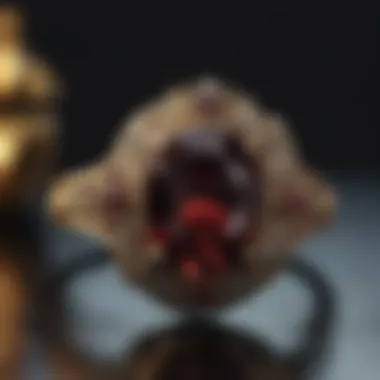

Key Points about Birthstones:
- Historical Origins: The practice may have been influenced by astrology and mythology.
- Symbolic Meaning: Each stone is thought to impart certain qualities to the individual.
- Cultural Variations: Different cultures have different lists of birthstones, adding diversity to their meanings.
Understanding garnet's place in these traditions allows individuals to enrich their knowledge, not just about the stone but also about themselves.
The Role of Birthstones in Culture
Birthstones play a significant role in various cultural practices, often associated with traditions, rituals, and personal milestones. Across the globe, cultures have crafted their own narratives around these stones, attributing specific meanings and powers.
For instance, in ancient Rome, people believed that wearing the garnet during the month of January would bring strength and safety. In several African cultures, garnets were thought to provide health benefits, a notion still cherished by some today. Many people give jewelry featuring birthstones as a gesture of love or importance, often marking significant life events like birthdays, anniversaries, or graduations.
"Birthstones transform mere minerals into emblems of personal significance; they become intertwined with our identities."
Cultural Expressions of Birthstones
- Gift-Giving: Offering garnet jewelry as a gift is a way to convey personal significance and thoughtfulness.
- Rituals and Celebrations: Many people incorporate birthstones in traditional celebrations, recognizing their significance in various cultures.
- Personal Symbolism: For many, a birthstone becomes a personal totem, symbolizing identity or aspirations.
In summation, the role of birthstones, particularly garnet for January, allows people to connect deeper with their culture and personal history. Each gemstone is a tale waiting to be told, serving as a bridge betwixt the past and the present.
The Garnet: An Overview
Garnets are more than just a pretty face in the world of gemstones. They have a fascinating story, rich in both history and symbolism. When we look at garnet, we're not just examining a stone; we're diving into an array of properties that extend well beyond their surface luster. This section aims to dissect the general qualities of garnet, ensuring that both laypeople and experts appreciate the specifics that mold its reputation.
Description and Characteristics
Garnets possess a distinctive array of characteristics that grant them their allure. Typically found in a variety of vibrant colors, including deep reds, pinks, greens, and super rare blues, these gemstones are often classified by their levels of transparency and brilliance. A key characteristic is the hardness of garnet, which ranks between 6.5 and 7.5 on the Mohs scale. This durability makes garnets a solid choice for jewelry that withstands the rigors of daily wear.
Another unique feature is garnet's capacity to change hues depending on the lighting conditions. This effect, known as color change, can make garnets particularly interesting for collectors. In addition, garnets exhibit a high refractive index, resulting in a fiery brilliance that can rival even more expensive stones like diamonds.
Types of Garnet
Almandine
Almandine garnet is perhaps the most recognized variety, often flaunting a rich red hue reminiscent of a deep, velvety wine. Its key characteristic lies in its strong color saturation, which is often synonymous with quality garnet. Almandine garnets are commonly found in a range of jewelry settings, making them a popular choice due to their durability and aesthetic appeal. A unique feature here is its historical use in the ancient world, often believed to offer protection to the wearer, particularly in battles. However, when sourcing almandine, one must beware of misidentified stones, as some may not meet the expected color and quality standards.
Pyrope
Moving on to Pyrope, this variant shines with a vivid cherry-red color that often calls to mind the imagery of ripe fruits. It's understood to be particularly beneficial for those seeking emotional grounding, making it popular among holistic practitioners. The unique aspect of Pyrope is its association with passionate love, lending it a romantic allure. While it is commonly noted for its stunning color, some varieties can be quite rare, which might drive up prices in specific markets.
Spessartine
Spessartine garnets present a departure from the classic red hues, often displaying vibrant orange and yellow shades. This particular type is not only eye-catching but also celebrated for its lower density and high brilliance. Spessartine garnets have become increasingly popular due to their unique colors, making them a great alternative for those looking to stand out. The disadvantage might be their relative softness compared to other garnets, making them less ideal for certain types of jewelry wear.
Grossular
Then we have Grossular garnets, which can exhibit a rainbow of colors—green being the most famous. Known for its clarity and unique flavors, like the well-known ‘mint garnet,’ Grossular has become popular among collectors and designers alike. Its versatility is apparent as it can range from understated elegance to bold and striking. However, their availability varies, and finding high-quality pieces can be a bit of a hunt, making it a curious challenge for enthusiasts.
Andradite
Finally, Andradite offers even more diversity, featuring color ranges from yellow to green and sometimes even brown. Its key characteristic is its high dispersion, giving it a unique sparkle. This garnet type is somewhat rarer than its cousins, which can add to its appeal for collectors. Yet, its market presence is not as prominent, making it a lesser-known yet fascinating addition to the garnet family.
Garnet is not merely a gemstone; it's a treasure trove of historical significance, emotional depth, and aesthetic diversity. Understanding its variations gives insight into its various cultural roles, enhancing appreciation for those who choose garnet as their birthstone or their stone of choice.
Historical Context of Garnet
The historical context of garnet is a rich tapestry woven with threads of culture, spirituality, and artistry. This gemstone has been used for centuries, not only for its aesthetic appeal but also for its believed metaphysical properties. Understanding the past can illuminate the significance of garnet in modern jewelry and its role in personal adornment. It’s not just about pretty stones; it's the legacy that garnet carries which intrigues so many collectors and enthusiasts today.
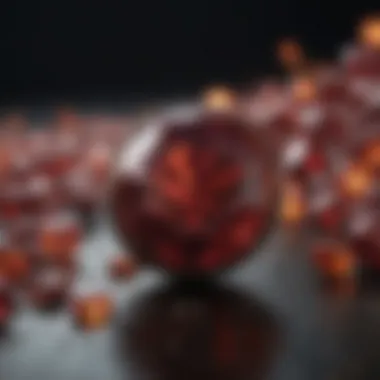
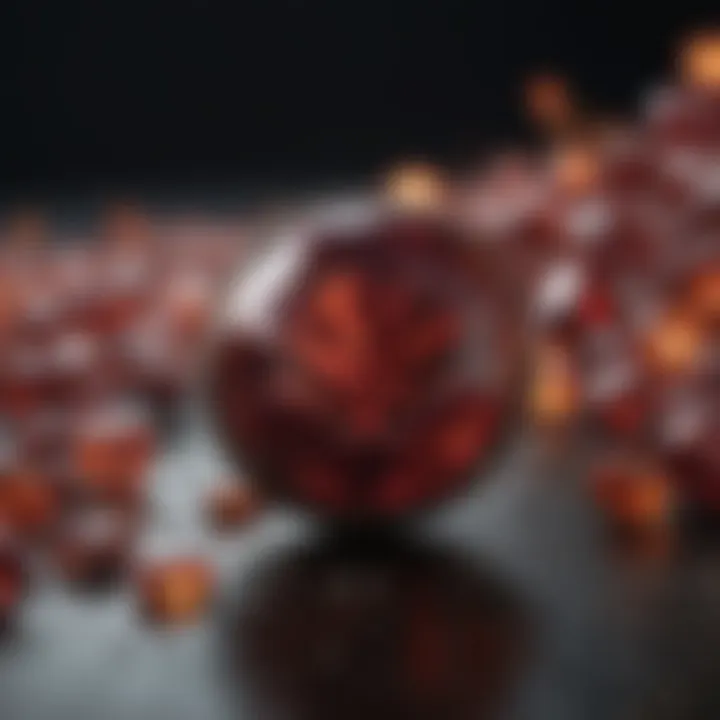
Origins of Garnet Usage
Garnet finds its roots deep within the earth's mantle. The earliest known use of garnet dates back over 5,000 years, originating in Egypt. There, artisans crafted it into intricately designed jewelry for Pharaohs and nobility. But its allure didn’t stop at adornment. Garnets were often buried with the dead, symbolizing safety in the afterlife and ensuring a smooth passage through the underworld. Such practices reveal how garnets were not merely prized possessions but were entwined with the spiritual beliefs of ancient civilizations.
Notably, in ancient Rome, gladiators donned garnets for protection, believing these gemstones would bring them strength and courage in battle. This usage signified a deeper meaning connected to valor and bravery, displaying garnet’s place in the hearts of warriors.
Garnet in Antiquity
Garnet's story expands to various cultures worldwide. In antiquity, garnets were highly sought after by the Romans, who exported them to regions far and wide. They adored the gemstone not just for its dazzling appearance but for its purported capabilities of healing and enhancement of the wearer’s physical strength. In fact, the word "garnet" is derived from the Latin word "granatus," meaning seed, likened to the seeds of pomegranate, which echoes the gem’s deep red hue. This association permeated culture, symbolizing fertility and prosperity in numerous civilizations.
Also, during the Middle Ages, garnets made a significant appearance in Europe, where they became one of the most coveted stones for royalty. Many crowns and regal ornaments contained garnets, signifying wealth and power. Kings and queens favored the stone not just for its beauty, but also for its protective qualities – they believed garnets guaranteed loyalty in their entourage.
Religious and Cultural Importance
Garnet’s importance transcended mere aesthetics to assume a role in religious and cultural practices. Different cultures attributed unique meanings to the stone. In Hinduism, garnets were linked to the divine, representing purity and the fire within. In Christian communities, garnets symbolized God’s eternal love, with biblical references showcasing the stone in the descriptions of heavenly realms.
Furthermore, in modern metaphysical beliefs, garnet is often associated with the root chakra, embodying grounding energy and stability. It is considered to promote faith, strength, and endurance in its semblance, encapsulating the energy of life itself. Such diverse perspectives illustrate how garnet resonates deeply in our shared human experience, from ancient beliefs to contemporary spiritual practices.
Garnet's vibrant history paints a picture of a gemstone intertwined with culture, spirituality, and artistry, making it a profound symbol for many.
In summary, the historical context of garnet enriches our understanding of its role today, emphasizing it as more than just a beautiful gemstone. It embodies the beliefs, traditions, and artistry of diverse cultures over millennia.
Properties of Garnet
When exploring Garnet, understanding its properties is crucial, not only for those selecting this stunning gemstone for personal use but also for enthusiasts and collectors who wish to gain deeper knowledge. The properties of Garnet range from its physical attributes to its metaphysical significance, each contributing uniquely to its allure and value. Knowing these can guide buyers in their decisions and enhance their appreciation of this remarkable stone.
Physical Properties
Hardness
Garnet scores a solid 7.5 to 8 on the Mohs scale, making it quite durable. This characteristic of hardness is a vital feature that speaks volumes about the gem’s reliability, particularly in jewelry applications. When you're wearing a piece featuring Garnet, you can rest assured it can withstand the everyday bumps and scrapes of life. This makes it a preferred choice for rings and bracelets, as they endure more wear compared to necklaces or earrings. However, despite its admirable hardness, it’s still important to treat Garnet with care, as rough handling can lead to scratches over time.
Color Variations
What truly sets Garnet apart is its vibrant palette, ranging from deep reds to sparkling greens and even blues, depending on the type of Garnet in question. This color variation captures a significant attention among buyers. For instance, Almandine Garnets typically boast a deep red hue, while Tsavorite, a variety of Grossular Garnet, dazzles in vivid green. The unique feature of color variability allows for a broad spectrum of design possibilities, thus catering to different tastes and preferences. However, prospective buyers should be aware that some colors are rarer than others, which can affect their price.
Clarity
The clarity of a Garnet plays an essential role in its overall beauty and value. Garnets can appear in a range of clarity levels, from eye-clean stones with no visible inclusions to those with noticeable imperfections. Usually, the clearer the stone, the more sought after it becomes in the market. As a key characteristic, clarity affects how light interacts with the gem. A clear Garnet reflects light beautifully, providing a mesmerizing sparkle that elevates any piece of jewelry. However, lower clarity stones may still be appreciated for their character and unique inclusions, making them ideal for certain aesthetic choices in jewelry design.
Metaphysical Properties
Energy and Vibrations
Many believe that Garnet possesses exceptional energy and vibrations, bringing a sense of vitality and passion to its wearer. This gemstone is often associated with igniting creativity and inspiring momentum. Its unique energy serves as a grounding force during turbulent times, enhancing one's ability to focus on goals. Those looking to harness such energies might find Garnet to be a valuable companion in both personal and professional pursuits.
Healing Properties
In traditional lore, Garnet has been linked to healing properties, believed to revitalize the body and spirit. Some advocate its potential benefits in improving circulation and boosting the immune system. This healing aspect appeals to individuals who are on a spiritual journey or those looking for holistic approaches to health. Although scientific evidence is limited regarding these claims, the belief in the healing properties of Garnet undoubtedly enhances its allure among gemstone enthusiasts.
Emotional Balance
On an emotional level, Garnet is viewed as a stone that fosters balance and stability within oneself. It’s often suggested that wearing or carrying Garnet can help individuals maintain their emotional well-being by alleviating feelings of anxiety and promoting positive energy. This emotional balance is particularly desirable for those navigating life's ups and downs. By cultivating a sense of calm, Garnet may be a helpful ally in emotional growth and healing.
"The beauty of a Garnet is not just in its aesthetic appeal, but also in the harmony it can bring to one’s life."
In summary, the properties of Garnet, both physical and metaphysical, contribute significantly to its charm and desirability. These elements make it not only a stunning gemstone but also a protective and comforting presence in people’s lives.


Garnet in Jewelry
Garnet, often recognized for its stunning hues and durability, holds a revered place in the world of jewelry. As a versatile gemstone, it can be found in a myriad of designs, catering to various styles and occasions. This section delves into the significance of garnet within jewelry, highlighting specific elements, benefits, and considerations that make it a favorite among collectors and designers alike.
Design and Settings
When it comes to incorporating garnet into jewelry, its deep, rich colors open the door to various creative designs. The most common shades include deep red and dark purple, but garnet also boasts a spectrum of colors, from vibrant orange to subtle green. This range enables jewelers to craft pieces that can either be understated and elegant or bold and eye-catching.
Some popular settings for garnet include:
- Solitaire Rings: A single garnet stone can make a statement on its own. The simplicity of a solitaire enhances the gem's natural beauty while maintaining an elegant look.
- Cluster Rings: Here, multiple smaller garnets can create a captivating effect, mimicking the appearance of a flower or vintage brooch.
- Earrings: Whether in studs or dangling formats, garnet earrings can add a splash of color to any outfit, making them versatile for everyday wear or special occasions.
For the more adventurous spirit, designers often pair garnet with other gemstones, such as diamonds or pearls. This not only enhances its visual appeal but also creates a unique contrast that magnifies garnet's allure.
Care and Maintenance
Caring for garnet jewelry isn’t a daunting task, but certain guidelines should be followed to keep it looking its best. Here are some tips on ensuring the longevity of garnet pieces:
- Cleaning: Use a soft cloth to gently wipe down garnet to remove any residue. For a more thorough cleaning, warm soapy water with a mild solution can be employed. However, avoid harsh chemicals, as they can damage the stone.
- Storage: Store garnet separately from other jewelry pieces. This prevents scratching, ensuring that its surface remains smooth and lustrous. A fabric-lined box or a soft pouch works well.
- Avoid Impact: Garnet is durable, but it’s still wise to protect it from sudden impacts that may cause chips or scratches. Always remove garnet jewelry during physical activities.
The importance of garnet in jewelry transcends mere aesthetics; it embodies passion, love, and commitment. Plus, knowing how to properly care for these pieces helps maintain their beauty over time, allowing the wearer to embrace the resplendence of garnet for years to come.
"Garnets, with their fiery tones and rich history, are not just stones; they are storytellers woven into the fabric of jewelry design."
Through thoughtful design and proper care, garnets can be appreciated not only as beautiful ornaments but also as treasured heirlooms.
Buying Guide for Garnet
When it comes to purchasing garnet, potential buyers should consider several key factors to ensure a quality gemstone that fits their needs. Knowing how to navigate the market can make a significant difference between a wise investment and a regrettable purchase. This section will provide insights that empower enthusiasts, collectors, and jewelers alike with essential information regarding quality identification and current market dynamics.
Identifying Quality
To choose a garnet that truly stands out, one must pay attention to several critical aspects. Quality is often determined by the gemstone’s physical properties, which can be broken down as follows:
- Clarity: Look for garnets with minimal inclusions or blemishes. In general, the clearer the stone, the more it will typically be worth. Crystals that exhibit visible flow lines or large internal flaws may indicate an inferior quality.
- Color: Garnet comes in a variety of shades; some are more prized than others. For example, deep red Pyrope garnets often fetch a higher price than lighter, yellowish varieties. Always consider what color resonates most with you, but also what garnet is trending.
- Cut: The cut of garnet affects its brilliance and overall appearance. A well-cut garnet should reflect light beautifully and exhibit a pleasing shape and proportion, enhancing its visual impact.
- Carat Weight: While larger stones can be more valuable, the quality of the stone remains paramount. A small, high-quality garnet can be more desirable than a larger stone of subpar quality.
"Quality garnet isn’t just about size; it’s about how well the stone captures light and emotion."
Market Trends and Pricing
Understanding the current market trends can help ensure you’re investing wisely in garnet. Here are some trends to watch:
- Popularity: With their unique hues and rich symbolism, garnets are increasingly sought after in both casual jewelry and high-end pieces. Collectors look for unique shades, particularly those exhibiting vibrant hues.
- Emerging Designs: Contemporary jewelry designs often incorporate garnet in innovative settings that accentuate its beauty. Pay attention to trending styles on platforms like Reddit and fashion blogs to gauge what designs are drawing interest.
- Pricing Fluctuations: Prices for garnet can vary widely based on the above quality factors, but also consider supply and demand. As garnet becomes more popular among designers, you might see an uptick in prices. Staying updated with market reports on sites like Wikipedia or Britannica can inform your purchase timing.
- Sourcing and Authenticity: Opt for reputable dealers who provide certifications and reports from gemological institutes, ensuring that your purchase is genuine. This can significantly impact valuation and future resale potential.
By keeping these considerations in mind when buying garnet, you can ensure not only that you acquire a beautiful gemstone but also that it remains a valued piece in your collection. Whether it’s for personal use or as an investment, understanding how to identify quality and navigate market trends is vital.
Finale
As we draw the curtains on our exploration of garnet and its significance as the birthstone for those fortunate enough to be born on January 15, it's vital to appreciate the depth of this gemstone's allure. Garnet stands not merely as a decorative stone but also as a bearer of history and sentimental value. With shades that echo the hues of sunset, garnets possess an almost magnetic quality that captivates onlookers and collectors, ensuring their popularity throughout the ages.
The Timeless Allure of Garnet
Garnet's journey from ancient times to the present encapsulates its enduring charm. Historically prized for its stunning variety in color—ranging from the rich, deep reds of Almandine to the vibrant greens of Tsavorite—this gemstone has established itself as a cultural touchstone across numerous civilizations.
- Cultural Significance: In many cultures, garnets have been linked to protection, prosperity, and love. Ancient warriors wore garnets as talismans for victory in battle, believing it would ensure not only their safety but would also bring them courage.
- Modern Meaning: In contemporary society, garnets embody a sense of loyalty and passion, making them ideal as gifts between loved ones. Whether symbolizing a unbreakable bond or marking significant life events, garnet's presence remains timeless.
The aesthetic appeal of garnet is not its only defining trait. The gemstone's physical properties, such as durability and brilliance, allow it to shine in various jewelry settings—from the simplest pendants to extravagant statement pieces.
Embracing the January Birthstone
For those celebrating their January birthdays, embracing the garnet symbolizes a connection to their roots and the vibrant energy of new beginnings. Wearing garnet can serve as a daily reminder of the warmth, strength, and fidelity prevalent in their lives.
- Jewelry Options: Incorporating garnet into your collection can be both a personal and stylish choice. Rings, necklaces, and bracelets featuring garnet not only reflect individual taste but also carry an air of sophistication and elegance.
- Personal Connection: Many gem enthusiasts enjoy researching garnet's varied types and properties, enhancing their bond with their chosen piece. Understanding the mineral's journey, from formation in exotic locations to becoming part of a meaningful piece of jewelry, enriches the experience.
In contemplating the garnet, one doesn’t merely think of a gemstone but rather a treasure steeped in significance, culture, and meaning. By choosing to embrace this stunning birthstone, individuals not only celebrate their own uniqueness but also connect with a rich narrative that transcends time. In doing so, garnet becomes not just a part of personal identity but a symbolic link to the past, making it a strikingly profound choice for jewelry enthusiasts and collectors alike.







